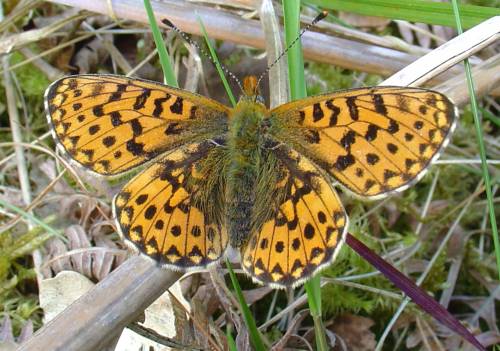A survey has revealed record numbers of a nationally rare butterfly – seen earlier than usual this year due to recent warm weather.
305 pearl bordered fritillaries have been recorded at Devon Wildlife Trust’s Marsland nature reserve. The rare butterflies were out earlier than usual, with 15 recorded on 9/10 April by national butterfly expert Roger Harding.
A full survey was undertaken on Monday 18 April by Devon Wildlife Trust’s senior nature reserves officer Gary Pilkington. The previous highest count – 288 - was recorded more than 10 years ago.

Pearl Bordered Fritillary © Scott Hackett, from the surfbirds galleries.
Pearl bordered fritillaries were counted in many areas of the site which had been cut and coppiced by Devon Wildlife Trust staff over the winter, with funding from Viridor. Gary Pilkington has been managing Marsland nature reserve for more than 20 years to improve the wooded valley’s glades and pastures for the benefit of these rare butterflies. It is one of the most closely monitored sites in the South West for butterflies and the knowledge accrued over the years is paying dividends. The 212 hectare site on the North Devon coast supports five species of fritillary: pearl bordered, small pearl bordered, silver washed, dark green and high brown.
Gary Pilkington, said:
“Over the years we have learnt exactly what pearl bordered fritillaries need to thrive here. It includes appropriate bracken control, scrub management and providing the open ground they love.
“They are readily responding to our long-term and careful management of this site, in particular to us opening up areas, especially where their food plant viola and main nectaring plant, bugle, heave on the woodland floor. To see them in big numbers in coppice - mainly hazel with some birch and oak – rather than their traditional haunt of bracken slopes is especially pleasing.
“This is the ideal time of the year to see pearl-bordered fritillaries in flight. It really is a spectacular sight to watch them flitter in amongst the coppice on a beautiful sunny day.”
Other butterflies recorded at Marsland on 9/10 April included four comma, more than 100 orange tip, 50 speckled wood, 10 holly blue, one red admiral, one small tortoiseshell, one green veined white, five small white and two wall brown.
Management work at Marsland nature reserve is carried out by Devon Wildlife Trust staff, local contractors and volunteers who help to remove gorse, willow, alder and other scrub in the habitats best suited to the butterflies. Devon Wildlife Trust is leading the way with improving habitat for pearl bordered fritillaries, and increasing numbers. It has three other sites where reserves officers are undertaking the same simple and effective management approach and reaping the rewards.